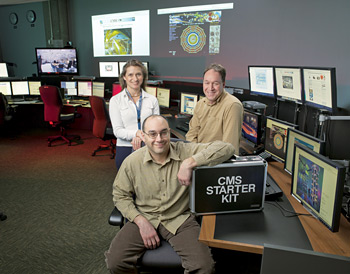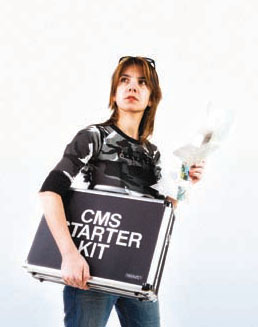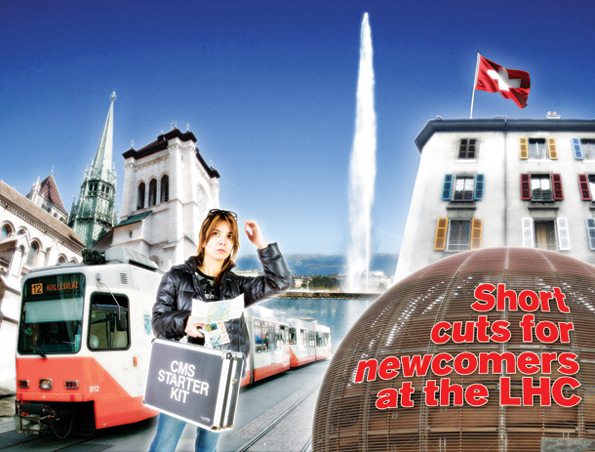Short cuts for newcomers at the LHC
It can take weeks to get into the groove of analyzing data from an unfamiliar detector. With a new starter kit, physicists at the Compact Muon Solenoid can cut that time to hours.
By Elizabeth Clements
|
When Sal Rappoccio, a postdoctoral researcher from Johns Hopkins University, joined the Compact Muon Solenoid experiment in mid-2007, he did what any newcomer would do. He tried to start his analysis.
It did not go well.
“Each group had its own computing tools,” says Rappoccio. “It was daunting for someone unfamiliar with the software. It took a few weeks just to get something working.”
 |
| In Fermilabs Remote Operations Center from left: Liz Sexton- Kennedy, Sal Rappoccio and Eric Vaandering represent a few members of the CMS Starter Kit Team. Photo: Reider Hahn, Fermilab |
Such rough beginnings are not unique to the Compact Muon Solenoid, or CMS, one of two giant experiments at the Large Hadron Collider in Geneva, Switzerland.
Graduate students learn physics in the classroom. When they join an experiment and try to start analyzing data, however, they find themselves in a world of chaos. The early stages of any experiment can be especially overwhelming.
“Nothing works when a new experiment starts, and you need help,” says Boaz Klima, a physicist at Fermi National Accelerator Laboratory in Illinois and member of the US CMS collaboration.
The solution used to be simple: Go down the hall, offer to buy a colleague a cup of coffee, and ask for help. That approach worked well for Rappoccio when he was a Harvard University graduate student on the CDF experiment at Fermilab.
Buying coffee for an experimenter on CMS, however, is not so simple. Coffee is still a valuable commodity, but CMS involves more than 2500 people from all over the world. In fact, many CMS collaborators will work from their home institutions and not actually live at CERN, the European particle physics center where the Large Hadron Collider is scheduled to start up this year.
Recognizing that a basic and consistent instruction manual might be useful, Fermilab's LHC Physics Center worked with other CMS collaborators to develop a set of user-friendly computing tools, or “starter kit.”
Essentially a tool box for physicists, the CMS starter kit provides researchers with a set of simple examples that lets them get started on their analyses right away. “The learning curve is so steep in a large experiment like CMS,” says Dan Green, co-coordinator of the LHC Physics Center. “We felt we had to do better, because speed is essential at a discovery machine.” The idea is to allow a user to create a graphic representation, or plot, of a particle collision in a matter of hours, rather than weeks.
“The main goal is to reduce frustration,” says Rappoccio. “The starter kit makes things simple so that newcomers can get reasonable results right away. It's for someone who is familiar with physics but not familiar with CMS.”
When the LHC starts up, data will pour in from up to 40 million particle collisions that occur each second in the CMS detector. A trigger system, which acts as a sort of spam filter, selects only the most interesting collisions, roughly 100 per second, for further study. Even so, what's left is an overwhelming amount of data. Giant computer farms store this data, and physicists later reassemble it into a form the human brain can grasp and analyze. Piecing the collisions together requires complex software with thousands of lines of code. To discover anything new, physicists must be able to speak a common language–a computing language.
That is where the starter kit comes in.
“If you don't have a simple way of getting people on the road, you lose them,” says Klima, who coleads the LPC Physics Forum, a weekly seminar for young CMS scientists.
Although the starter kit started as a US endeavor, it didn't take long for all of CMS to embrace the idea and make it an official project. In fact, a Physics Analysis Tools group already existed for CMS, and the starter kit project fit right into its charge. The collaboration appointed a starter kit team, including Steven Lowette from the University of California, Santa Barbara; Elizabeth Sexton-Kennedy and Eric Vaandering from Fermilab; and Petar Maksimovic and Rappoccio from Johns Hopkins. Other CMS collaborators helped, too. “A lot of tools already existed,” Rappoccio says. “It was just a question of putting things together in a user-friendly way.”
The starter kit consists of a number of “building blocks” that recognize specific particles–for instance, muons or electrons–coming out of collisions. Like templates for a Web page, they allow the user to plug in information and generate immediate results. Later, researchers can customize the computer code to suit their needs. Each building block comes with the collaboration's guarantee that it will work.
After testing the new tools on a few fellow physicists, the team launched Starter Kit 1.0 at a CMS tutorial workshop for graduate students and postdocs in January. For now, physicists are using the kit to analyze simulated data.
The early reviews are positive.
Malina Kirn, a graduate student at the University of Maryland, says she likes the kit because it's a great way to start an analysis and “not worry about mistakes.”
Kevin Flood, a postdoc at the University of Wisconsin-Madison, describes the starter kit as satisfaction guaranteed: “It gives you a real sense of accomplishment.”
The starter kit builds on a tradition of preparing people to dive into an experiment. At Fermilab, for example, the CDF and DZero collaborations held tutorials for newcomers. Klima recalls recording DZero tutorials on videotape in the early 1990s; some institutions even bought copies of the tapes for their users.
 |
ATLAS, the other gigantic detector at the Large Hadron Collider, also has a set of analysis tools to get members started. Based on a handbook from the BaBar experiment at the Stanford Linear Accelerator Center, the ATLAS workbook introduces experimenters to the detector's software and describes basic analysis steps. Last year, ATLAS started another workbook dedicated solely to physics analysis.
CMS also has a workbook, modeled on tools that ATLAS developed. Since both ATLAS and CMS have many members who used to work on BaBar, it's natural for them to have similar software tools.
Although the CMS team based parts of its starter kit on the workbook, they say it's fundamentally different because it was designed with the user in mind. And while they originally developed the kit for newcomers, it's intended to become a repository of CMS-certified code that's useful to anyone. A newcomer starts with the building blocks; a more experienced experimenter can use the starter kit to test more complicated scenarios. “If you have an idea, you don't want it to be months later before you find out if it works,” Rappoccio says.
Now that the starter kit is launched, the team serves as the starter kit help desk. In addition to providing user support, they are adding more sophisticated physics tools for expert users. In fact, Kirn, who helped test-drive the kit, is already working on a more advanced set of tools.
With the ever-evolving starter kit providing a common language, physicists will be able to jump into the analysis of their mountains of data right away, leading to quicker scientific results and, ultimately, a faster pace of discovery.
Click here to download the pdf version of this article.







